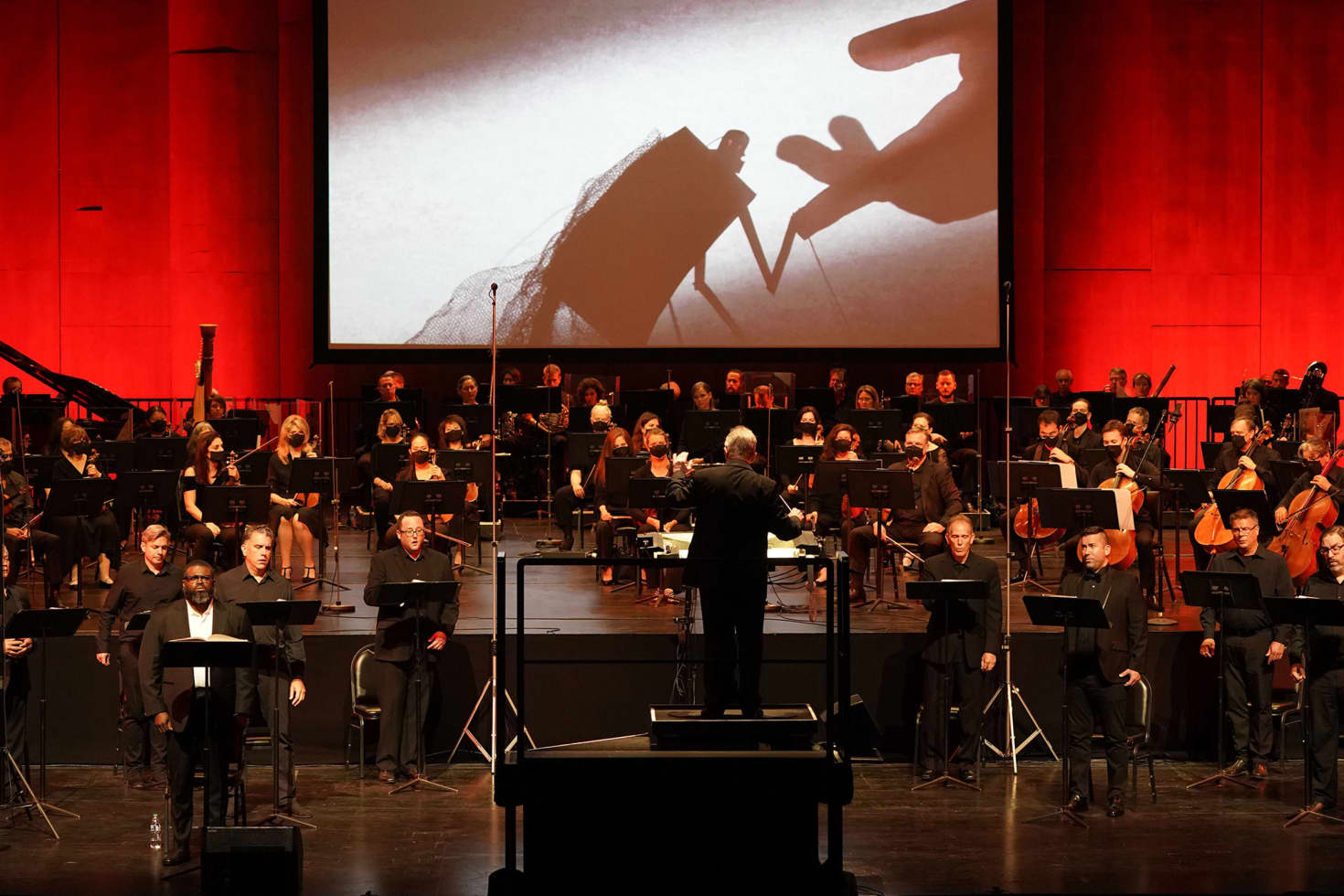Maestro Conlon dives deep into Stravinsky's highly stylized work.
A Note from Music Director James Conlon
“Thebes is prostrate. After the Sphinx, the plague.”
—opening narration, Oedipus Rex
After more than a year of the COVID pandemic, as LA Opera begins to emerge from our long shutdown, it seems appropriate that we acknowledge it through a work that begins under not just the threat but the scourge of a plague. Igor Stravinsky’s Oedipus Rex, an opera/oratorio (as the composer described it), is such a work.
Like so much great Stravinsky, it has a unique and unconventional profile. It was born of a striking and particular set of parameters that were set by the composer himself. It is a hybrid between oratorio (static, non-theatrical and religious, though the composer emphasized that this work was not religious) and opera (dramatic and theatrical, though Stravinsky shuns action here). It is a hybrid between an imagined ancient Greek theater and the contemporary Parisian world of playwright, poet and novelist Jean Cocteau, with whom Stravinsky’s relationship was alternatively warm and frosty.
So, it was to be dramatic yes, but not melodramatic. It was to recount a story, but to narrate it without emotion. It was to be monumental and purposely static, its characters presented with a stiff formality (like statues in a wax museum, it was dryly noted), each performing their assigned scene and then withdrawing from the stage. Thus, in the composer’s words, “the stage figures are more dramatically isolated and helpless…the portrait of the individual as victim of circumstances is made far more starkly effective.”
Stravinsky chose to set a text in Latin precisely because he wanted a so-called “dead language” that the audience is meant not to understand. His choice of story, from Greek literature, was also distant yet familiar to the audience in its broad outlines. What little plot is necessary to know is recounted to the public with a simple narration. These are all ways of distancing the listener from his or her typical habits of experiencing opera. You are to listen clinically, coldly if you will.
And yet, paradoxically, the theatrical experience is powerful. Once again, the Stravinsky of The Rite of Spring intended to shock and shake up his audience, and with Oedipus Rex he achieves this with absolute mastery. The Picasso of composers once again demonstrated that he was always unmistakably himself, but constantly presenting himself and re-presenting himself in new forms and surprising ways, always on his terms.
(An aside: my introduction to the story of Oedipus in high school was not Sophocles, Cocteau or Stravinsky. For smart aleck teenagers of the sixties, the revelation was comedian Tom Lehrer and his now iconic songs of the era. His song “Oedipus Rex” is worth hearing.)
Whether we’ve read Sophocles or not or were exposed to Freud or not (if so, how could one not have heard of Oedipus?), here is the plot, stripped down to its basics.
The gods are displeased, and they have punished the great city of Thebes with a plague. The people call upon Oedipus, their revered king, to solve the problem, just as he did years earlier by solving the riddle of the Sphinx. Creon, brother of Queen Jocasta (the wife of Oedipus), explains that the plague has been sent because the murderer of the previous king, Laius, remains in Thebes. The seer Tiresias learns from the Oracle that the murderer of King Laius is a king.

(Photo: Lawrence K. Ho)
Queen Jocasta is at first skeptical of the Oracle. In the course of time, she discovers that Oedipus, as a young man, unwittingly killed King Laius (his biological father, unbeknownst to him) on his way to Thebes where, for solving the riddle of the Sphinx, he was rewarded with the crown and married to the widowed queen.
It turns out, of course, that she is his mother. The gods have caught the couple in a trap: Oedipus has murdered his father and married his mother (thus inspiring Freud’s Oedipus Complex). Ignorance of their guilt is not a defense, and they are punished severely by the gods. They have brought ruin on Thebes and the plague will not be lifted until they are expelled. Humiliated and wracked by guilt, Jocasta hangs herself. Oedipus, before setting out in exile, gouges out his eyes.
A grim end, but this is of course the stuff of opera. Unlike a Puccini melodrama, we don’t see any of the final events, we hear them narrated and recounted by a very Greek chorus. That is the distance imposed by Stravinsky. With the help of the narrator, only the bare bones need be presented. Stravinsky writes in an eclectic neoclassic style, using fragments of forms known from Baroque and classical operas, and he keeps us focused on the music by depriving us of the opportunity to experience the sung text in a language we can understand. Additionally, the choice of Latin was effective for the large Roman Catholic public in Paris (where it premiered), an effective way to give the impression of ritual theater rather than melodrama.
The text was written by the prominent French playwright and author Jean Cocteau. The sung text was then translated into Latin by a brilliant young Jesuit theologian (later Cardinal) Jean Daniélou. Thus, there is no common language with the public. The material is not dead, but petrified, becoming monumental and immunized against civilization. The narration is to be translated into the vernacular of the country wherever the work is presented; the English translation is by none less than the poet e.e. cummings.
The chorus in Oedipus Rex has the conventional collective character of a traditional Greek chorus: reacting, participating, observing, commenting. The chorus is all men, divided into four parts, a practice drawn from his Russian roots. The orchestra is standard, including harp and piano, dominated by woodwinds, and sparse on percussion, with the exception of the timpani. The narrator provides just enough of the story to keep us focused.
Let’s walk through the score.
The opera opens without introduction with an outburst, an outcry from the male populace. It is a Verdian gesture reminiscent of Otello but the music is 100% Stravinsky (though the melodic outline bears a resemblance to one of the heroine’s phrases in the first act of Aida, “Pietà ti prenda del mio dolor"). The chorus sings “The plague falls on us, Thebes is dying of plague! From the plague preserve us.” Stravinsky utilizes no Wagnerian leading motives (Leitmotifs), but there is a figure played by the timpani, harp and piano, outlining the interval of a minor third, which will prove omnipresent. It is an ostinato, a short phrase that is repeated constantly throughout a composition. Its “obstinate,” obsessional character suggests destiny, and not a nice one: inescapable fate, tragedy predestined from birth.
Oedipus is introduced next, singing “I, illustrious Oedipus, love you, and will save you.” The ornamental style of his aria seems patterned on a Baroque prototype. It suggests his facile and flexible mind as well as his fatuousness; he describes himself as “ego clarissimus" (most illustrious).
Creon, brother of the queen, arrives, announcing the oracle’s proclamation that the murderer of the King Laius must be found. Pompous and bombastic, Creon sings to a banal march that gathers all of the force of the orchestra.

(Photo: Lawrence K. Ho)
Next comes another aria of Oedipus, who promises to solve the mystery and find the murderer. The music here is firmly rooted in the key of E-flat major, which gradually emerges as the royal tonality. Again, this is not a Wagnerian motive, just a frame of reference.
After the narrator reveals that the assassin of the king is a king, the orchestra takes up the repetitious ostinato fate motive, with the celli and basses now reinforcing the original timpani, harp and piano.
The seer Tiresias (paradoxically blind) is a deep bass, and generously shares his deep, low notes with us. He sings slowly, clearly and without passion or emphasis. He could almost be a character from Mussorgsky’s Boris Godunov (perhaps Pimen, the holy monk). He starts rigidly and almost monotonously. The two-note ostinato reappears: The king must be driven from Thebes. Tiresias concludes royally and authoritatively with “Rex peremptor regis est": The king is a king’s murderer.
Without interruption, this connects into another aria for Oedipus, again in E-flat major. “Envy hates the fortunate, they want to destroy the king,” he sings. Without understanding the deeper implications of the seer’s words, Oedipus accuses Tiresias of personal vengeance. It is not; it is the decree of the gods. Tiresias understands this, Oedipus does not.
Next comes a magnificent choral “Gloria,” to praise, glorify and welcome Queen Jocasta to the stage. It could be from a Mass, but the timpani and choral imitation reveal its closer relation to Mussorgsky and Boris Godunov than to Händel and the “Hallelujah Chorus.”
Jocasta’s great scene stops the argument. She chides all for arguing. Oracles lie, she asserts. As evidence, she explains that Laius was slain at a crossroads and not, as another oracle had predicted, murdered by her son. The scene is rich with allusions. Its introduction starts with the orientalism of the harp and flute sounding in G minor (reminiscent of the scene in Aida between Aida and the Pharoah’s daughter). Its appearance is particular effective as a contrast to the G major of the “Gloria" chorus.
Now comes the aria proper, which will have three sections and a repetition of the first, a baroque technique. The first section is slow and sensuous, with harp accompaniment throughout (starting with the two-note fate ostinato) and three clarinets, perhaps meant to be reminiscent of the aulos, an ancient Greek instrument played in pairs. Then comes a contrasting fast section, still featuring the clarinets. Then perhaps the most memorable section of all “Oracula mentita sunt” (the oracles lie). Jocasta repeats this over and over, with the recurring minor-third Fate motif and a rapid four-note pattern reminiscent of Beethoven’s Fifth Symphony (which, legend tells us, depicts Fate knocking at the door).

(Photo: Lawrence K. Ho)
The sensuous first section is repeated verbatim until she proclaims that Laius was murdered at a crossroads, “trivium” in Latin. The chorus takes up that fateful word. Oedipus is afraid; he knows he murdered an old man at a crossroads. He wants to find the shepherd who witnessed the crime. It is a conventional stretto, a passage in a faster tempo, at the end of the aria.
The shepherd and a messenger appear and tell the story. Oedipus has understood. His final moment combines a shudder in the orchestra in D minor (the traditional tonality of death) with, of course, the minor third from the Fate ostinato, which is sharply contrasted by a major third on the flutes, a luminous moment of clarification. The contrast here of major and minor is essential.
The messenger describes the suicide of Queen Jocasta, and the gouging of Oedipus’ eyes. He repeats the words “Divum Jocasta caput mortuum,” (the divine Jocasta is dead). Stravinsky, with self-deprecating humor referred to it as a “four-word singing telegram.”
The chorus then describes the horrific scene. Ever ironic, Stravinsky called its dance-like symmetry “a mortuary tarantella.” The horrified (and horrifying) chorus recapitulates the opening bars of Act One to the words “Behold! Oedipus the king shows himself a most foul monster, a most foul beast.” At the end, the chorus intones “Farewell Oedipus; I loved you.” Then he, and all of them, fade away to the two-note ostinato fate theme, proving that it was all predestined from the beginning.







